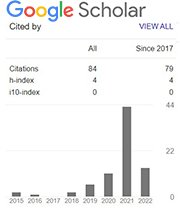ORIENTASI MASA DEPAN REMAJA PEMULUNG DI SAMARINDA
Abstract
ABSTRACT
This study aims to identify the future orientation of youth trash picker in Bukit Pinang final waste; to analyze influencing factors; and formulate an intervention model to improve the future orientation of youth trash picker. The data collection used the scale of future orientation and semi-structured interviews to determine the factors which affect the future orientation of youth trash picker. The method refers to the five stages consisting of the organization, reading and marking data, description, classification, and the interpreted the data into codes and themes, interpreted the overall data, and restated as well as displays the analytical data. The result indicated that the future orientation of trash picker in Bukit Pinang TPA in general is in the average category (medium) with influencing factors consisting of optimism factor (belief) toward the ideals, achievement, support and obstacles, readiness to achieve goals, and emotional regulation. The intervention needed to improve the future orientation of trash picker is a reconstruction of cognition which aims to change the way in which non-supportive thinking becomes supportive through a systematically practiced skill training process.
Keywords: future orientation; youth trash picker; optimism
ABSTRAK
Penelitian ini bertujuan untuk mengidentifikasi orientasi masa depan remaja pemulung di TPA Bukit Pinang; menganalisa faktor yang mempengaruhi; dan merumuskan model intervensi guna meningkatkan orientasi masa depan remaja pemulung. Metode pengumpulan data menggunakan skala orientasi masa depan dan wawancara semi terstruktur untuk mengetahui faktor yang mempengaruhi orientasi masa depan remaja pemulung. Metode analisa yang digunakan mengacu pada lima tahapan yang terdiri dari organisasi data; membaca dan menandai data; deskripsi, klasifikasi, dan inpretasi data menjadi kode dan tema; melakukan interpretasi data keseluruhan; dan menyajikan kembali dan menampilkan data hasil analisis. Hasil penelitian ini menunjukkan bahwa orientasi masa depan remaja pemulung di TPA Bukit Pinang secara umum berada pada kategori rata-rata (sedang) dengan faktor-faktor yang mempengaruhi terdiri dari faktor optimisme (keyakinan) terhadap cita-cita, pencapaian prestasi, dukungan dan hambatan, kesiapan meraih cita-cita, serta regulasi emosi. Intervensi yang dibutuhkan untuk meningkatkan orientasi masa depan remaja pemulung adalah sebuah rekonstruksi kognitifyang bertujuan untuk mengubah cara berpikir dari yang tidak mendukung menjadi mendukung melalui proses latihan keterampilan yang diakukan secara sistematis.
Kata kunci: orientasi masa depan, remaja pemulung, optimisme
Keywords
Full Text:
PDF (Bahasa Indonesia)References
Creswell, J. W. (2013). Five Qualitative Approaches to Inquiry - Phenomenological Research. Qualitative Inquiry and Research Design: Choosing among Five Approaches. https://doi.org/10.1017/CBO9781107415324.004
Desmita, R. (2008). Psikologi perkembangan. Bandung: PT. Remaja Rosdakarya.
Feist, J. & Gregory J. Feist. (2008). Theories of Personality (Edisi Keenam). Yogyakarta: Pustaka Pelajar.
Gillham, J., Reivich, K., & Shatte, A. (2002). Positive Youth Development, Prevention, and Positive Psychology: Commentary on “Positive Youth Development in the United States”. Prev. Treat. https://doi.org/10.1037/1522-3736.5.1.518c
Hartati, S. (2012). Pendekatan kognitif untuk menurunkan kecenderungan perilaku deliquensi pada remaja. Jurnal Humanistik, IX (2), 123-146.
Hurlock, E.B. (2014). Psikologi perkembangan. Jakarta: PT Raja Grafindo Persada.
Kamaratih, D., Ruhaena, L., & Prasetyaningrum, J. (2016). Pelatihan Berpikir Optimis Untuk Meningkatkan Orientasi Masa Depan Remaja Tuna Daksa. Jurnal Intervensi Psikologi, 8(2), 250–262.
Kementerian Pendidikan dan Kebudayaan RI. (2014). Baru 63.055 anak yang ditarik dari pekerjaan. http://paudni.kemdikbud.go.id/berita/6069.html. Diakses pada 12-12-2017.
Kementerian Sosial. (2012). Pedoman pendataan dan pengelolaan data penyandang masalah kesejahteraan sosial dan potensi dan sumber kesejahteraan sosial. Jakarta
Knafl, K. A. (1991). Patton, M.Q. (1990). Qualitative evaluation and research methods (2nd ed.). Newbury Park, CA: Sage, 532 pp., $28.00 (hardcover). Research in Nursing & Health. https://doi.org/10.1002/nur.4770140111
Nurmi, J. E., & Aunola, K. (2005). Task-motivation during the first school years: A person-oriented approach to longitudinal data. Learning and Instruction. https://doi.org/10.1016/j.learninstruc.2005.04.009
Nuttin, J. M. (1985). Narcissism beyond Gestalt and awareness: The name letter effect. European Journal of Social Psychology. https://doi.org/10.1002/ejsp.2420150309
Öner, B. (2001). Factors predicting future time orientation for romantic relationships with the opposite sex. Journal of Psychology: Interdisciplinary and Applied. https://doi.org/10.1080/00223980109603709
Seginer, R., & Noyman, M. S. (2005). Future orientation, identity and intimacy: Their relations in emerging adulthood. European Journal of Developmental Psychology. https://doi.org/10.1080/17405620444000201
Shaughnessy, J. J., Zechmeister, E. B., & Zechmeister, J. S. (2012). Research Methods in Psychology. Ninth Edition. Research methods in psychology. https://doi.org/10.1038/nmat4728
Taufik, I. (2013). Persepsi masyarakat terhadap pemulung di pemukiman tpa kelurahan bukit pinang kecamatan samarinda ulu. Journal Sosiologi.
Trommsdorff, G. (1983). Future orientation and socialization. International Journal of Psychology. Vol. 18, 381-406.
DOI: https://doi.org/10.21107/personifikasi.v10i1.5689
Refbacks
- There are currently no refbacks.
Copyright (c) 1970 Dewi Kamaratih, Karina Putri Alamanda

This work is licensed under a Creative Commons Attribution 4.0 International License.


Personifikasi by Universitas Trunojoyo Madura is licensed under a Creative Commons Attribution 4.0 International License.










